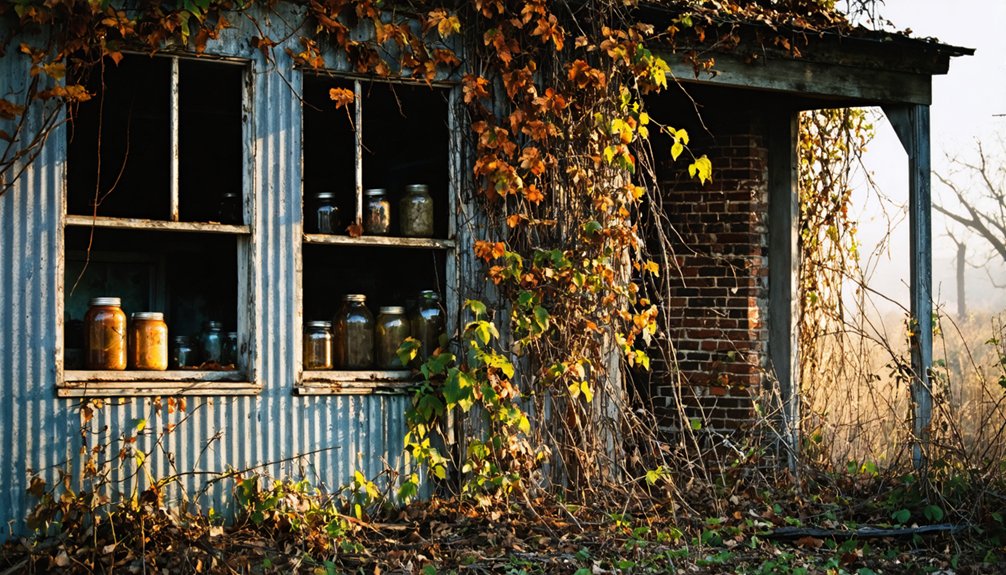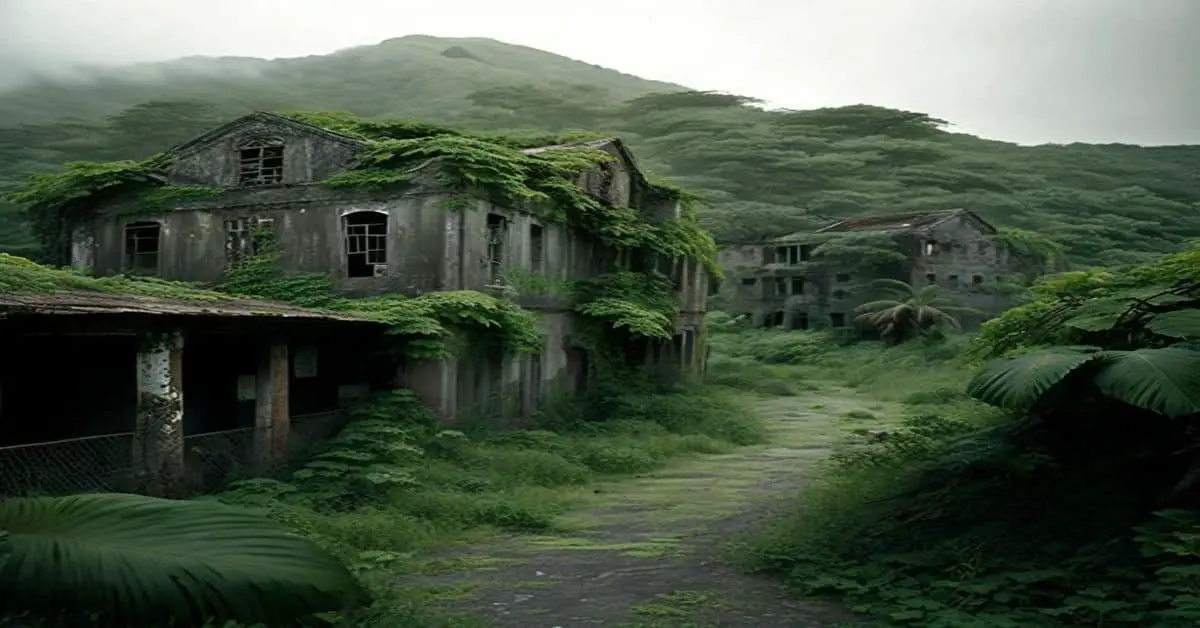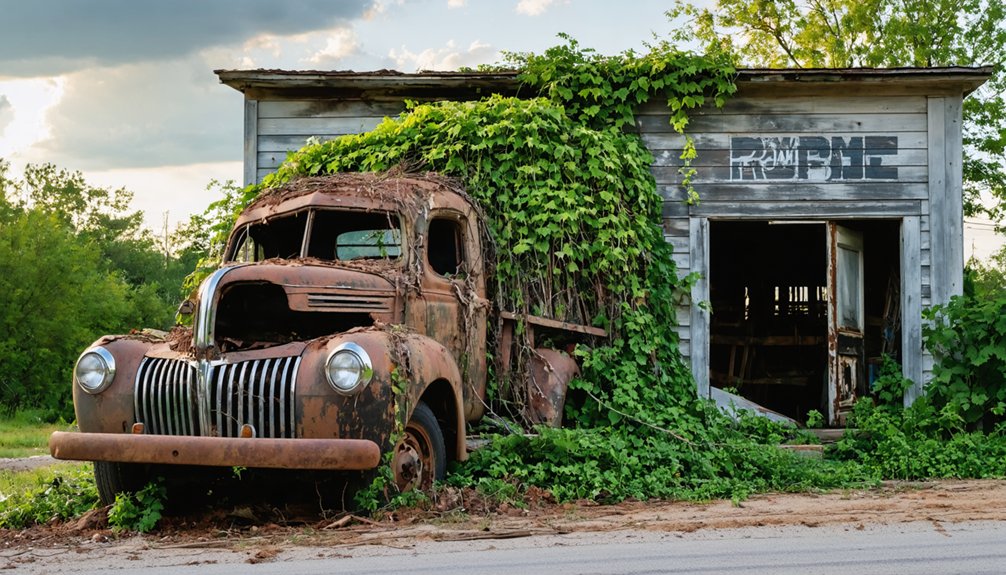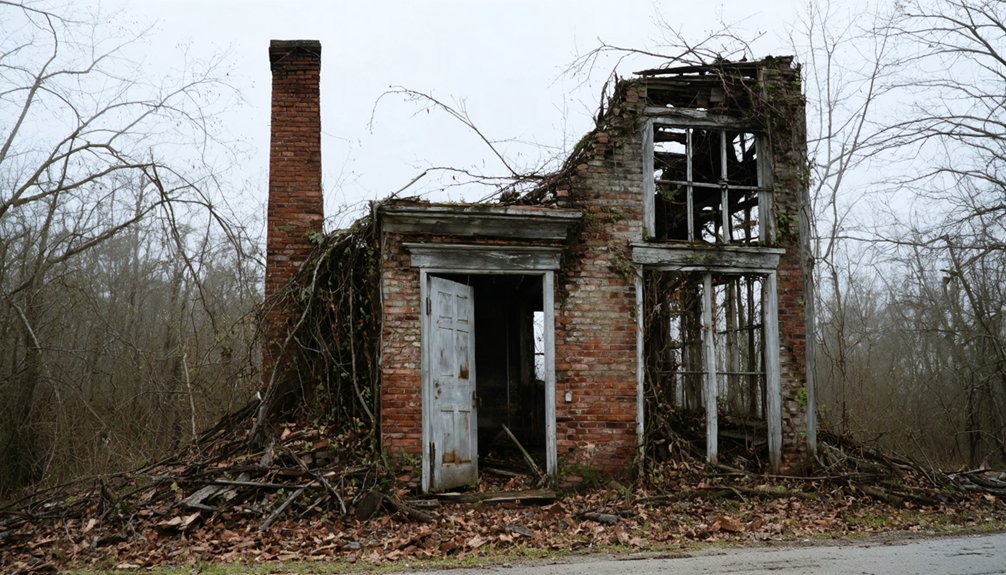You’ll find Morgan Stream nestled in Morgan County, Alabama, where a once-bustling cotton mill town now stands silent among Appalachian foothills and mixed hardwood forests. The community thrived through three distinct phases: agricultural prosperity, industrial growth, and eventual decline. Today, local preservation efforts focus on protecting the town’s remaining structures and documenting its rich textile heritage. The story of this Tennessee River basin ghost town reveals fascinating chapters of Alabama’s industrial past.
Key Takeaways
- Morgan Stream was a ghost town in Alabama centered around a cotton mill during the state’s textile industry era.
- Located in Morgan County within the Tennessee River basin, the town featured strategic waterways for cotton and timber operations.
- The town experienced three distinct phases: agricultural prosperity, industrial growth, and eventual decline leading to abandonment.
- Early residents relied on family farming, with cotton as the primary cash crop, supported by the area’s fertile river valleys.
- Historical preservation efforts include archaeological surveys, artifact cataloging, and documentation through local archives and the Alabama Historical Commission.
The Lost Town of Morgan Stream: A Historical Overview
While many ghost towns in Alabama emerged from political or military roots, Morgan Stream stands apart as a tribute to the state’s industrial heritage. You’ll find its story woven into the fabric of Alabama’s cotton mill era, where the rhythmic hum of textile machinery once defined daily life.
Unlike well-documented ghost town narratives of places like Cahaba or Fort Morgan, Morgan Stream’s exact origins remain somewhat mysterious.
While neighboring ghost towns boast clear historical records, Morgan Stream’s beginnings fade into the mists of Alabama’s past.
What’s known is that the town grew around a large cotton mill, typical of post-Reconstruction industrial expansion. The mill provided not just employment but formed the heart of a thriving community, complete with worker housing and essential services. Similar to the coke ovens of Battelle, these industrial remnants still dot the landscape.
Today, the site stands abandoned, its remains a silent indication to the rise and fall of Southern textile manufacturing.
Economic Rise and Decline
Three distinct economic phases marked Morgan Stream’s trajectory: agricultural prosperity, industrial growth, and eventual decline.
You’ll find that the town’s early economic resilience stemmed from its strategic location along Morgan Stream, where cotton fields and timber operations thrived. The region drew support from railroad companies that established transportation routes through the area. As population dynamics shifted upward, the community expanded with mills, artisan shops, and merchant establishments.
The town experienced challenges similar to those that affected Southern shipping companies during the Civil War period. The town’s fortunes began to waver when it faced mounting challenges. You’d have seen the impact of agricultural market crashes, devastating floods, and the exodus of workers to larger industrial centers.
The once-bustling streets grew quiet as businesses shuttered their doors. Without the economic foundation to sustain itself, Morgan Stream’s infrastructure crumbled, and its population dwindled until only empty buildings remained as evidence of its former significance.
Life in Early Morgan Stream
As you’ll learn, much of Morgan Stream’s early settlement housing featured basic wooden structures that fit the era’s frontier lifestyle, though definitive architectural records haven’t survived.
Local efforts aimed at preserving historical structures help maintain what little remains of the original settlement architecture.
The town’s agricultural foundations centered around family farming plots where settlers worked together through seasonal cycles of planting and harvesting, though specific crop details remain uncertain.
Limited historical documentation suggests community gatherings likely revolved around shared agricultural activities and faith-based meetings, reflecting patterns seen in similar Alabama settlements of the period. Similar to the historic town of Cahaba, Morgan Stream faced challenges with maintaining accurate records of its early development.
Daily Agricultural Practices
Life in early Morgan Stream centered around farming, with daily agricultural practices reflecting the diverse cultivation methods common throughout Alabama.
You’d have found yourself tending to a variety of crops including corn, wheat, and potatoes, while managing livestock that thrived in the local climate. Your mornings would’ve started with hog and cattle care, essential activities given the region’s strong livestock tradition.
The heavy clay soils posed constant challenges, but you’d have used heavy plows to work the land effectively. Like many farmers of the era, you would have practiced slash-and-burn agriculture to prepare new fields. Family members worked together to maintain the farm’s daily operations.
As a Morgan Stream farmer, you’d have focused considerable attention on cotton cultivation, the area’s primary cash crop. The nearby waterways proved invaluable for shipping your cotton to market, while your preserved pork sustained you through the seasons.
Social Gatherings and Traditions
While farmers worked their fields and tended livestock each day, the social fabric of Morgan Stream remains largely a mystery to historians.
You won’t find documented records of the social customs or community rituals that might’ve brought these Alabama settlers together. Though neighboring ghost towns like Fort Morgan and Old Cahawba offer glimpses of 19th-century life, you can’t assume Morgan Stream followed similar patterns.
If Morgan Stream was like other rural Southern communities, you might’ve gathered at the local church for Sunday services, celebrated harvests with your neighbors, or attended seasonal fairs.
But without primary sources, diaries, photographs, or oral histories to confirm these activities, the true nature of Morgan Stream’s social life continues to elude modern researchers.
Early Settlement Housing Styles
Early settlers in Morgan Stream built their homes to withstand the rugged Alabama frontier, drawing on both necessity and tradition.
You’d find most homes near Cotaco and Flint creeks, where families used local timber for log construction. These dwellings showcased the resourcefulness of your pioneering ancestors, who adapted Southern Appalachian building techniques to the hilly terrain. The abundance of fertile valleys and waterways made these areas prime locations for settlement.
The region became increasingly populated as Cherokee communities established themselves in Alabama during the late 18th century.
Living in Morgan Stream meant embracing simple yet practical housing solutions:
- Dogtrot cabins featured two single-room structures connected by a breezy covered walkway.
- Hand-hewn logs joined without nails using dovetail or saddle notch techniques.
- South-facing entries maximized natural light, with small windows covered by oiled paper.
Your daily life centered around the hearth, where you’d cook meals, stay warm, and gather with family as night fell over the Alabama wilderness.
Natural Environment and Geographic Features
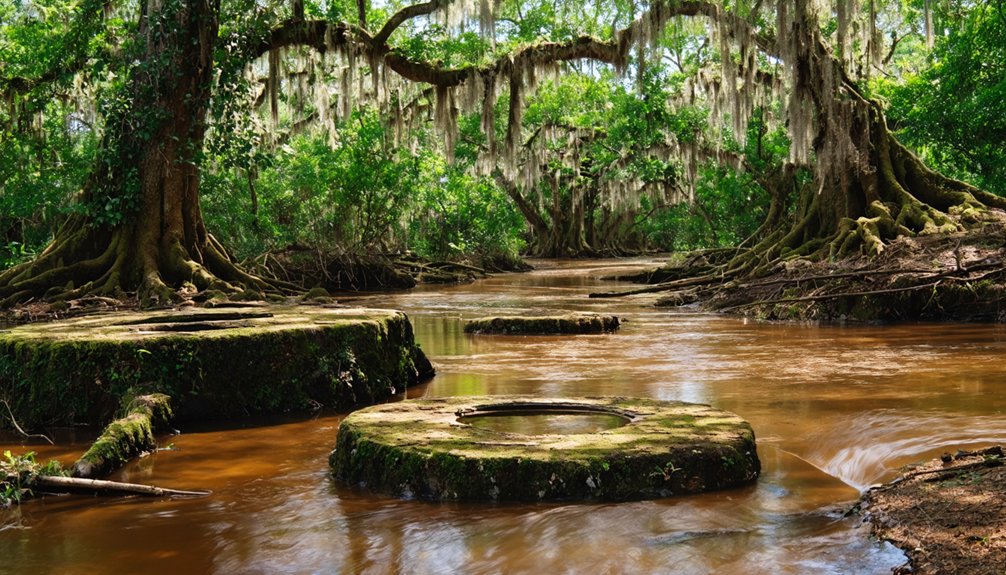
Nestled in Morgan County’s northern reaches, Morgan Stream occupies a distinctive location within Alabama’s Tennessee River basin. You’ll find yourself surrounded by Appalachian foothills, where mixed hardwood forests dominate the landscape.
Deep in Alabama’s river country, Morgan Stream winds through ancient Appalachian valleys, where hardwoods rise from the Tennessee Basin’s fertile soil.
The area’s ecological reclamation has transformed former settlement sites into lush wilderness, with Spanish moss draping ancient oaks and native groundcover flourishing beneath.
The region’s riparian flora thrives along the waterways, including native cane valleys locally known as “Cahaba.” You’ll discover a humid subtropical climate that supports diverse wildlife, from deer to local bird species.
The fertile river valleys, formed by alluvial soils, once sustained agriculture but now nourish regenerating forests. Despite the natural beauty, these same waterways that enabled early commerce also brought seasonal flooding, ultimately influencing the town’s fate.
Preserving Morgan Stream’s Legacy
You’ll find a wealth of historical documentation about Morgan Stream through local archives and the Alabama Historical Commission’s preservation records.
The community’s ongoing efforts to preserve this ghost town’s legacy include volunteer programs where you can participate in archaeological surveys and help catalog artifacts.
Through educational initiatives and public events, you can join fellow history enthusiasts in documenting oral histories and contributing to the growing collection of photographs and materials that tell Morgan Stream’s unique story.
Historical Documentation Efforts
Through coordinated efforts of local historical societies and state archives, Morgan Stream’s legacy continues to be preserved through thorough documentation strategies. The archival strategies include collecting historical photographs, maps, and government records that tell the story of this once-thriving community.
Oral history plays a significant role, as interviews with former residents and their descendants capture personal accounts that might otherwise be lost to time.
Key documentation initiatives include:
- Creation of digital archives making historical materials accessible to researchers and the public
- Use of advanced technology like drones and 3D scanning to document remaining structures
- Collection and preservation of census records and historical maps that track the town’s evolution
Community Engagement Opportunities
Building on the established documentation efforts, Morgan Stream offers numerous ways for the public to actively participate in preserving its rich heritage.
You can join regular community cleanup days to maintain historic structures and clear overgrowth, or share your knowledge at local storytelling events that keep the town’s oral histories alive.
If you’re interested in hands-on learning, you’ll find workshops teaching basic preservation techniques and opportunities to lead guided tours.
Students can participate through school programs, while history enthusiasts can engage in field research projects with partnering universities.
The town’s annual heritage festival lets you experience historical reenactments, while digital platforms enable you to contribute to virtual tours and online archives, ensuring Morgan Stream’s legacy lives on through community involvement.
Ghost Town Tourism Opportunities
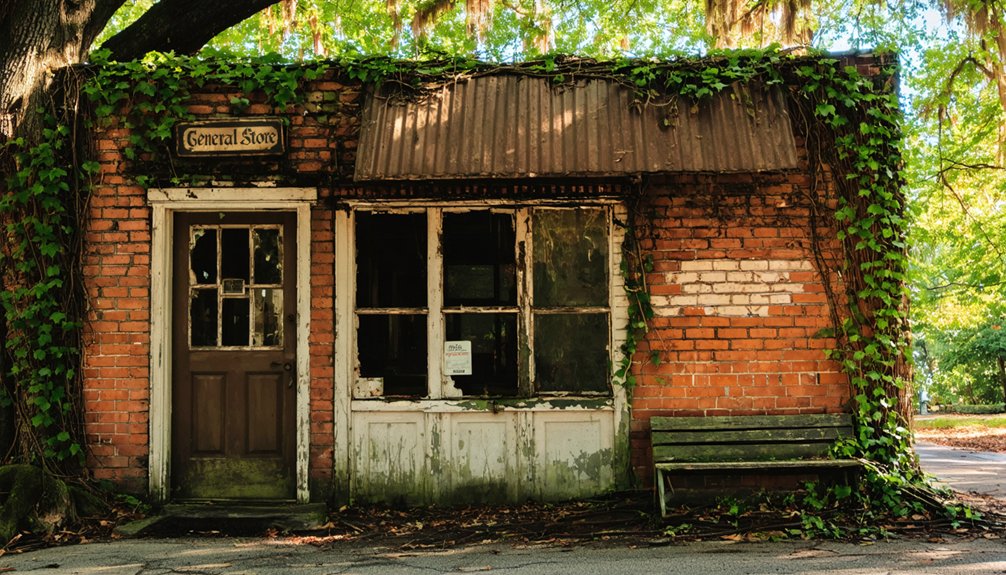
Morgan Stream’s ghost town status presents unique tourism opportunities that can revitalize the local economy while preserving its historical legacy.
By developing tourism potential, you’ll find numerous ways to experience this fascinating slice of Alabama history while supporting local preservation efforts.
- Explore guided tours through Morgan Stream’s historic buildings, where you can capture stunning photographs and learn about the town’s past through expert local guides.
- Participate in seasonal festivals and historical reenactments that bring the ghost town’s rich heritage to life, complete with period costumes and authentic cultural experiences.
- Take advantage of newly developed visitor amenities, including marked trails, interpretive signage, and rest areas that make your exploration comfortable while maintaining the site’s historical integrity.
Frequently Asked Questions
Are There Any Remaining Structures or Ruins Still Visible in Morgan Stream?
You’ll find nothing but sawmill ruins and a rumored cemetery – no remaining buildings or significant historical artifacts stand today. Time and neglect have erased most traces of this forgotten community.
What Native American Tribes Originally Inhabited the Morgan Stream Area?
You’ll find the Cherokee and Creek (Muskogee) tribes were the primary native peoples in this area, with Cherokee settlements like Creek Path and Creek Confederacy groups sharing this cultural heritage.
Were There Any Notable Crimes or Legends Associated With Morgan Stream?
Mysteries mainly remain, as you’ll find no documented crimes or detailed legends. Local folklore surrounding unsolved mysteries might exist, but there’s no verified record of significant incidents in the area.
Did Morgan Stream Have Its Own School System or Church?
You won’t find documented school history or church significance for this location, as historical records don’t show evidence of either educational facilities or religious institutions operating there.
What Happened to the Cemetery and Burial Grounds of Morgan Stream?
While cemetery preservation wasn’t prioritized, you can still find the burial grounds deep in the woods. Strip mining operations nearly destroyed it, but someone spared the site, leaving weathered headstones as silent witnesses.
References
- https://www.onlyinyourstate.com/experiences/alabama/historic-battle-site-ghosts-al
- https://alabamabucketlist.com/ghost-towns-in-alabama/
- https://en.wikipedia.org/wiki/Cahaba
- https://www.apr.org/arts-life/2017-10-31/alabama-ghost-trail-iii-old-cahawba
- https://www.youtube.com/watch?v=NplH1TF86Ro
- https://www.youtube.com/watch?v=bQbMaBZsrro
- https://www.youtube.com/watch?v=R7CbEhIOwnE
- https://en.wikipedia.org/wiki/List_of_ghost_towns_in_Alabama
- https://www.selmatimesjournal.com/2015/10/16/old-cahawba-shares-its-haunted-history/
- https://en.wikipedia.org/wiki/Charles_Morgan_(businessman)
